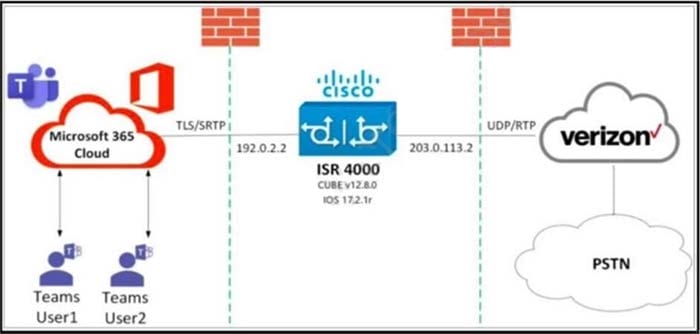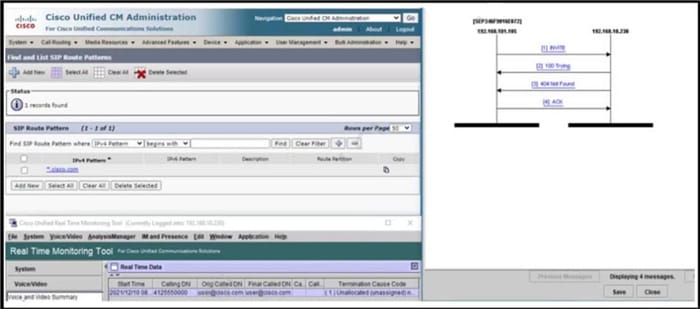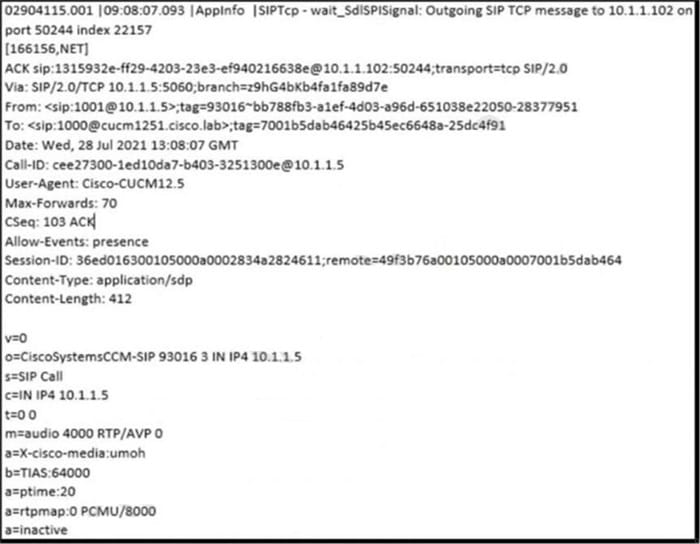Exam Details
Exam Code
:300-815Exam Name
:Implementing Cisco Advanced Call Control and Mobility Services (CLACCM)Certification
:CCNP CollaborationVendor
:CiscoTotal Questions
:213 Q&AsLast Updated
:Jul 25, 2025
Cisco CCNP Collaboration 300-815 Questions & Answers
-
Question 21:
Customers that call into a company's IVR report that when they try to select an option, none of the prompts work. The administrator determines that the calls are coming in across an H.323 gateway. While analyzing the dial peer that points toward Cisco UCM, the administrator notices that no DTMF method is configured. Which command resolves this issue?
A. dial-peer voice 2 voip dtmf-relay sip-kpml
B. dial-peer voice 2 voip dtmf-relay h245-alphanumeric
C. dial-peer voice 2 voip dtmf-relay sip-notify
D. dial-peer voice 2 pots dtmf-relay h245-alphanumeric
-
Question 22:

Refer to the exhibit. A collaboration engineer is troubleshooting an issue where a user of a Cisco UCM IP phone reports failed calls when trying to dial out to the PSTN. Which action resolves the issue?
A. Assign a calling search space to the line or the device that has access to the route pattern.
B. Deselect “Block this pattern” on the “Route Option” setting of the route pattern.
C. Select the “Urgent Priority” setting on the route pattern.
D. Instruct the user to not dial a “1” before their local area code.
-
Question 23:
An administrator deployed a third-party H.323 gateway in a voice environment, but users report call failures when using features like call hold or call transfer. What are two reasons that these features fail? (Choose two.)
A. The CSS of the transfer initiating line does not contain the partition of the supplementary feature extension (DirectTransfer or MoH Number).
B. The MTP that is configured for use within the H.323 gateway configuration is configured as a trusted source, but the third-party gateway does not trust the signing root CA certificate of the MTP certificate.
C. The MTP does not support the negotiated codec, and media renegotiating during the call is not supported.
D. The Media Resource Group List of the H.323 gateway contains only transcoders and conference bridges but no MTP.
E. The third-party gateway does not support supplementary features, so Media Termination Point (MTP) must be inserted.
-
Question 24:
An administrator manages an environment with mobile users who commonly move between locations and take IP phones to remote sites. When mobile users are at one of the sites, users report issues with call quality, such as the audio cutting in and out. In addition, the affected area has a low bandwidth connection compared to other sites, so the administrator has put these devices in a region with an inter-region restriction of 8 kbps per call. Which feature must the administrator configure to mitigate the issue?
A. Location Bandwidth Manager
B. Extension Mobility
C. Device Mobility
D. Extension Mobility Cross Cluster
-
Question 25:
An administrator is configuring Cisco UCM and the system to send *.webex.com traffic to a Cisco UCM Session Management Edition cluster. The administrator wants to limit which endpoints can reach *.webex.com. Which two items must the administrator configure for the SIP route pattern? (Choose two.)
A. calling party transformation
B. partition of the SIP route pattern
C. connected party transformation
D. called party URI transformation
E. destination SIP trunk of the SIP route pattern
-
Question 26:
An administrator is configuring a new deployment using Cisco Unified CME. The SCCP phones register without any issues, but SIP phones are not registering. Assume that all other configuration is valid. Which code allows SIP phones to register to Cisco UCME?
A. voice service voip allow-connections sip to h323
B. voice service voip sip bind media source-interface Vlan100
C. voice service voip sip bind control source-interface Vlan100
D. voice service voip sip registrar server expires max 600 min 60
-
Question 27:

Refer to the exhibit. An administrator configured Device Mobility but is receiving reports that local calls are failing when a user takes their device from the RTP location to the Charlotte location. The administrator confirmed that the correct subnet is configured under the Device Mobility info page. In addition, the roaming device pool has the correct Device Mobility calling search space selected. Which configuration change resolves the issue?
A. Join across lines is not supported with Device Mobility and must be disabled.
B. The network locale must be changed from none to the Charlotte locale.
C. The physical location must be updated from none to the appropriate location.
D. The device must be added to the Device Mobility group.
-
Question 28:

Refer to the exhibit. A company is using Microsoft Teams with Cisco Unified Border Element integration, but the administrator sees a one-way audio issue with Microsoft Teams. The administrator must modify the SIP profile to send the proper information on the SDP for IP address for media to match the internal and external interface. Which set of commands resolves the issue?
A. voice class sip-profiles 1 request INVITE sdp-header Connection-Info modify “2\.76\.1” “2.78.1”
B. voice class sip-profiles 1 request INVITE sdp-header Session-Owner modify “27\.0\.0” “27.3.0”
C. voice class sip-profiles 1 request INVITE sdp-header Connection add “2\.76\.1” “2.78.1”
D. voice class sip-profiles 1 request INVITE sdp-header Audio-Attribute modify “2\.76\.1” “2.71.1”
-
Question 29:

Refer to the exhibit. A collaboration engineer is troubleshooting a Cisco UCM issue where users report that calls placed to the domain cisco.com are failing and calls to sip.cisco.com are working. Which action resolves the issue?
A. Change the “Route Partition” setting on the *.cisco.com route pattern.
B. Add a SIP route pattern for *.*.
C. Select “Block Pattern” on the *.cisco.com route pattern.
D. Delete the *.cisco.com route pattern.
-
Question 30:

Refer to the exhibit. This message is sent to the device being placed on hold for the Music On Hold audio setup. The held party reports receiving dead air rather than music when the call was put on hold. The software Music On Hold server on Cisco UCM is used in this scenario. Assume that the audio leg between the Music On Hold server and the held device uses G.711, and the relevant region relationship is configured for 64 kbps. What is the cause of the issue?
A. The bandwidth configured for this region relationship is too low and must be increased to 96 kbps or higher.
B. The device that is placed on hold does not support G.711, and a transcoder could not be allocated for the call.
C. Cisco UCM is sending a=inactive to the held device.
D. The Music On Hold server does not support G.711 and a transcoder could not be allocated for the call.
Related Exams:
300-810
Implementing Cisco Collaboration Applications (CLICA)300-815
Implementing Cisco Advanced Call Control and Mobility Services (CLACCM)300-820
Implementing Cisco Collaboration Cloud and Edge Solutions (CLCEI)300-835
Automating Cisco Collaboration Solutions (CLAUTO)350-801
Implementing and Operating Cisco Collaboration Core Technologies (CLCOR)
Tips on How to Prepare for the Exams
Nowadays, the certification exams become more and more important and required by more and more enterprises when applying for a job. But how to prepare for the exam effectively? How to prepare for the exam in a short time with less efforts? How to get a ideal result and how to find the most reliable resources? Here on Vcedump.com, you will find all the answers. Vcedump.com provide not only Cisco exam questions, answers and explanations but also complete assistance on your exam preparation and certification application. If you are confused on your 300-815 exam preparations and Cisco certification application, do not hesitate to visit our Vcedump.com to find your solutions here.